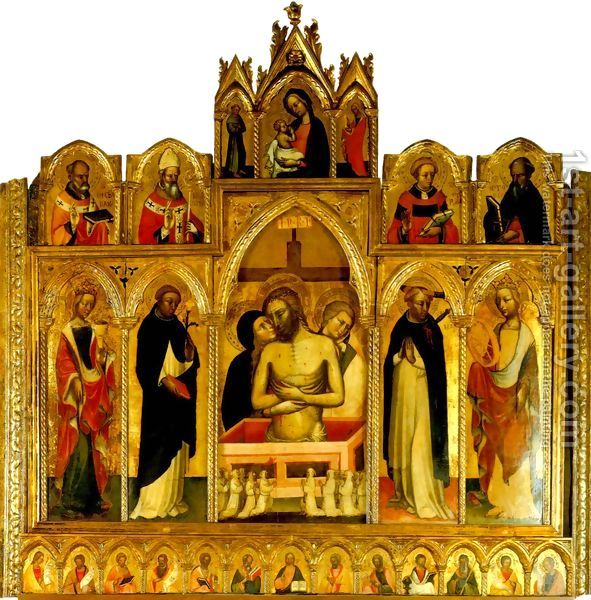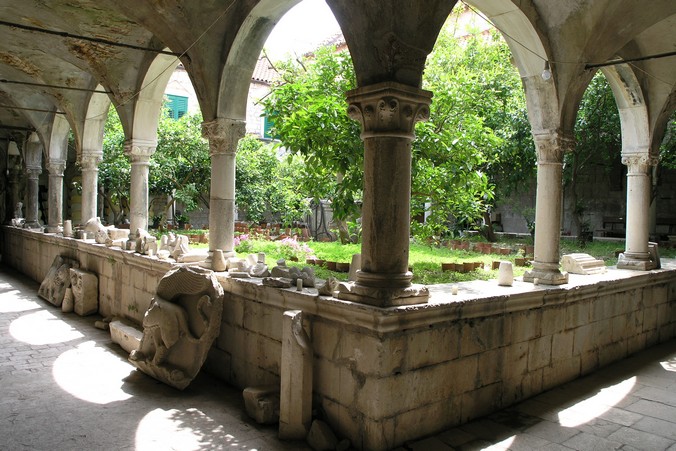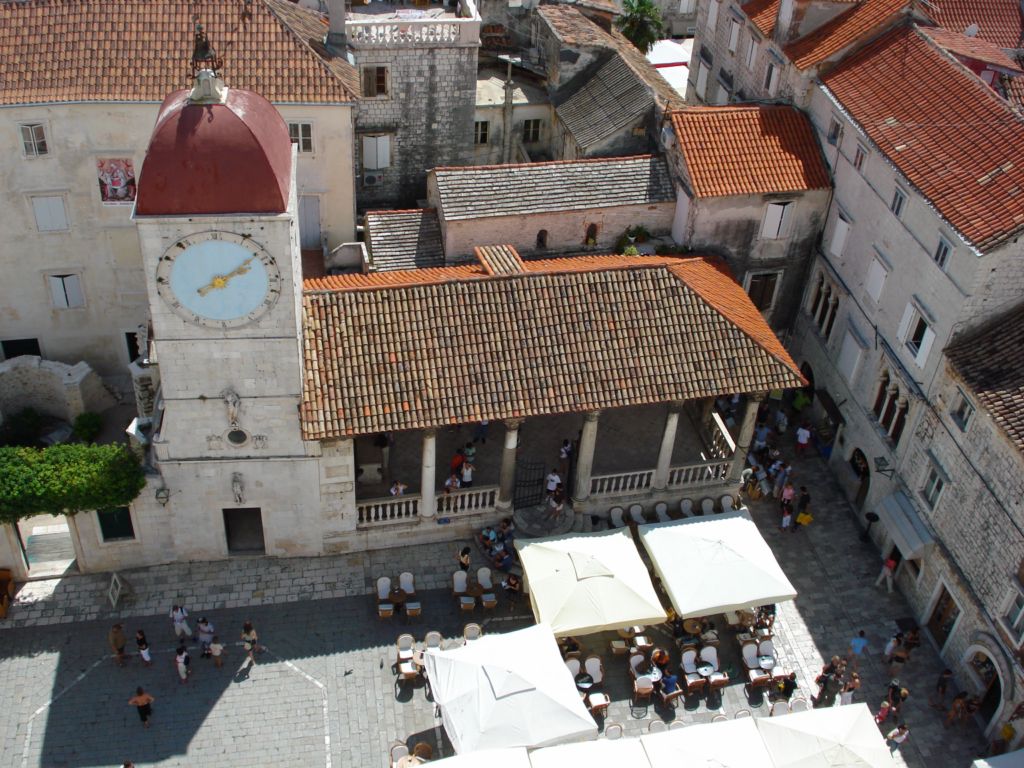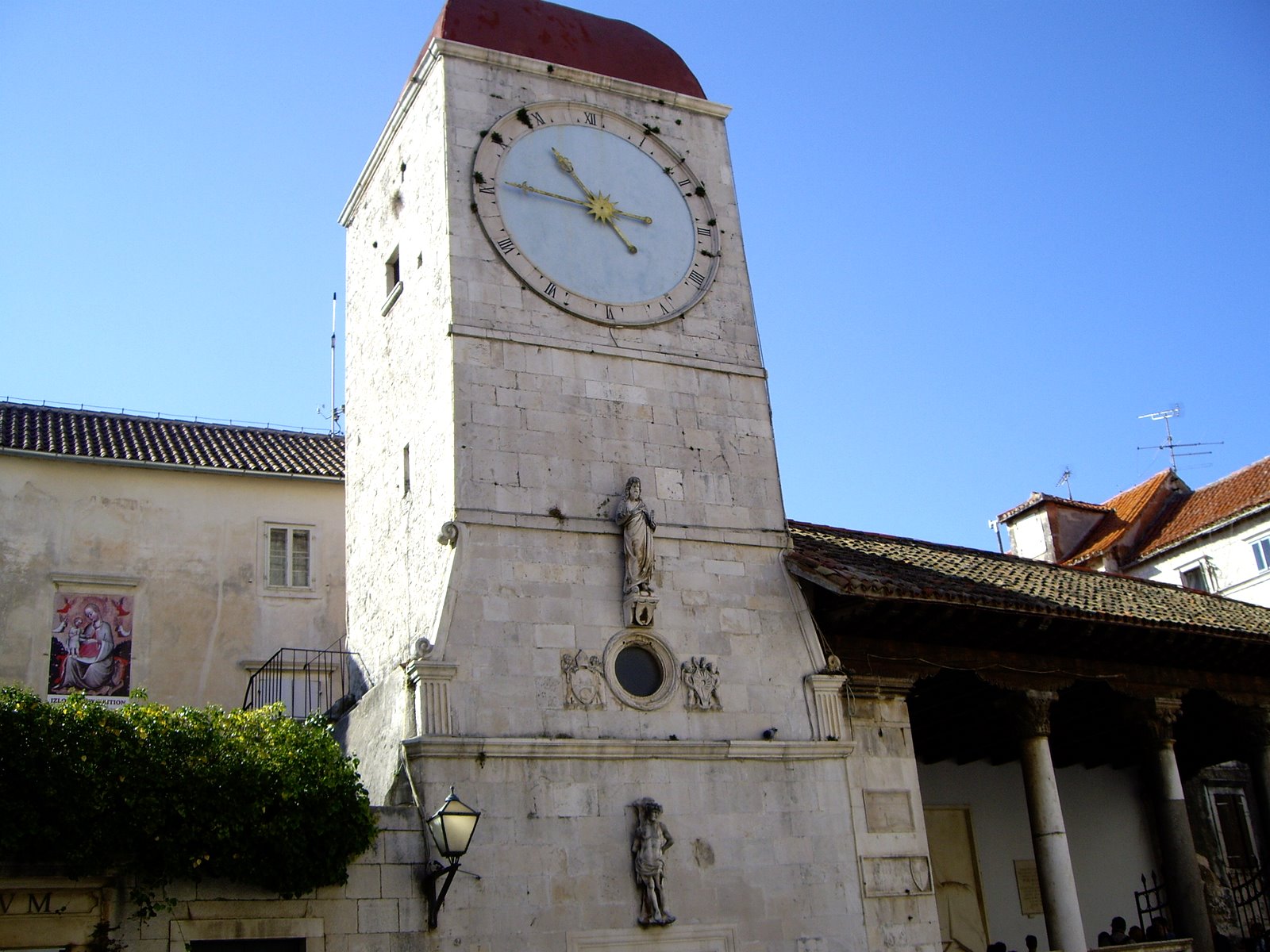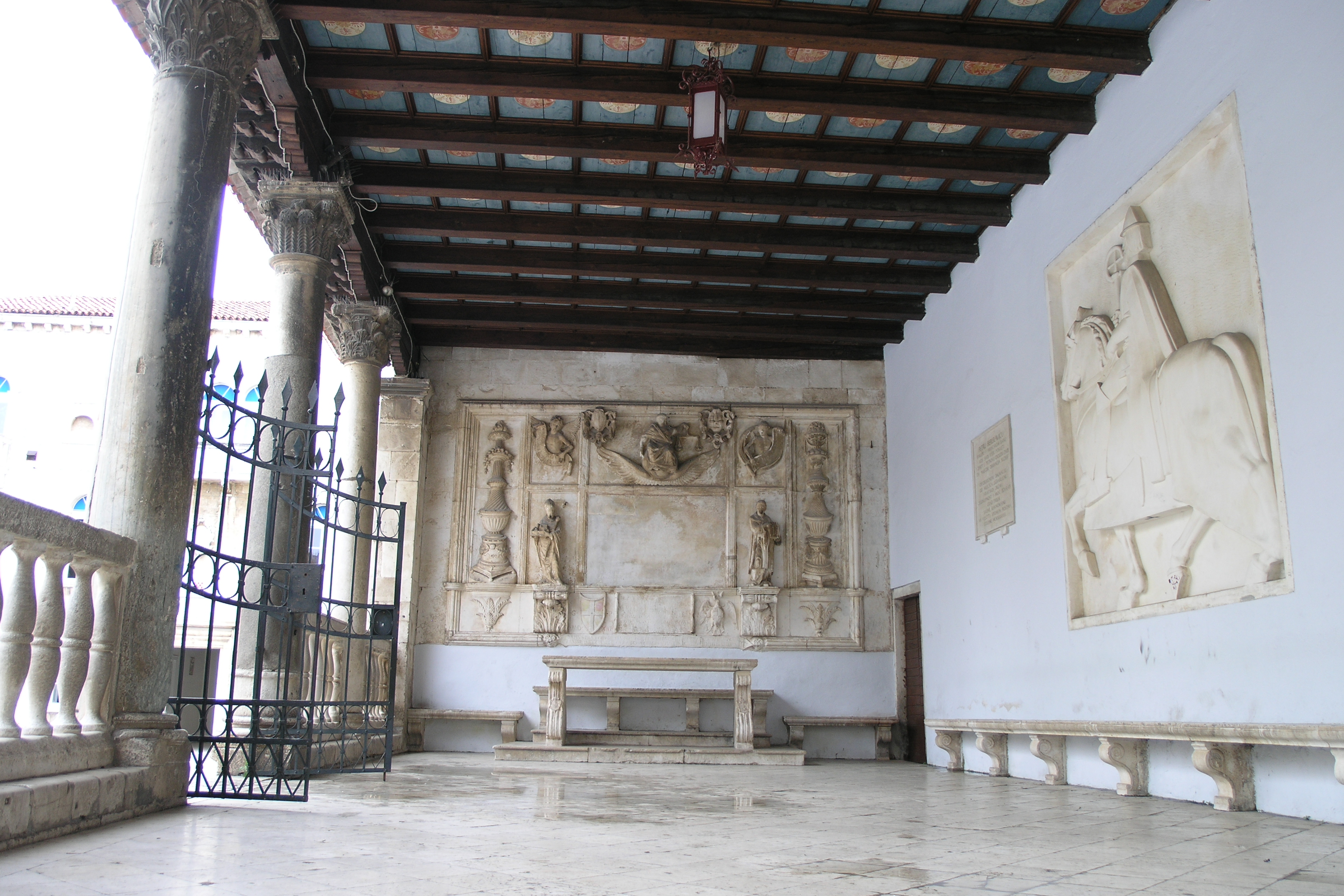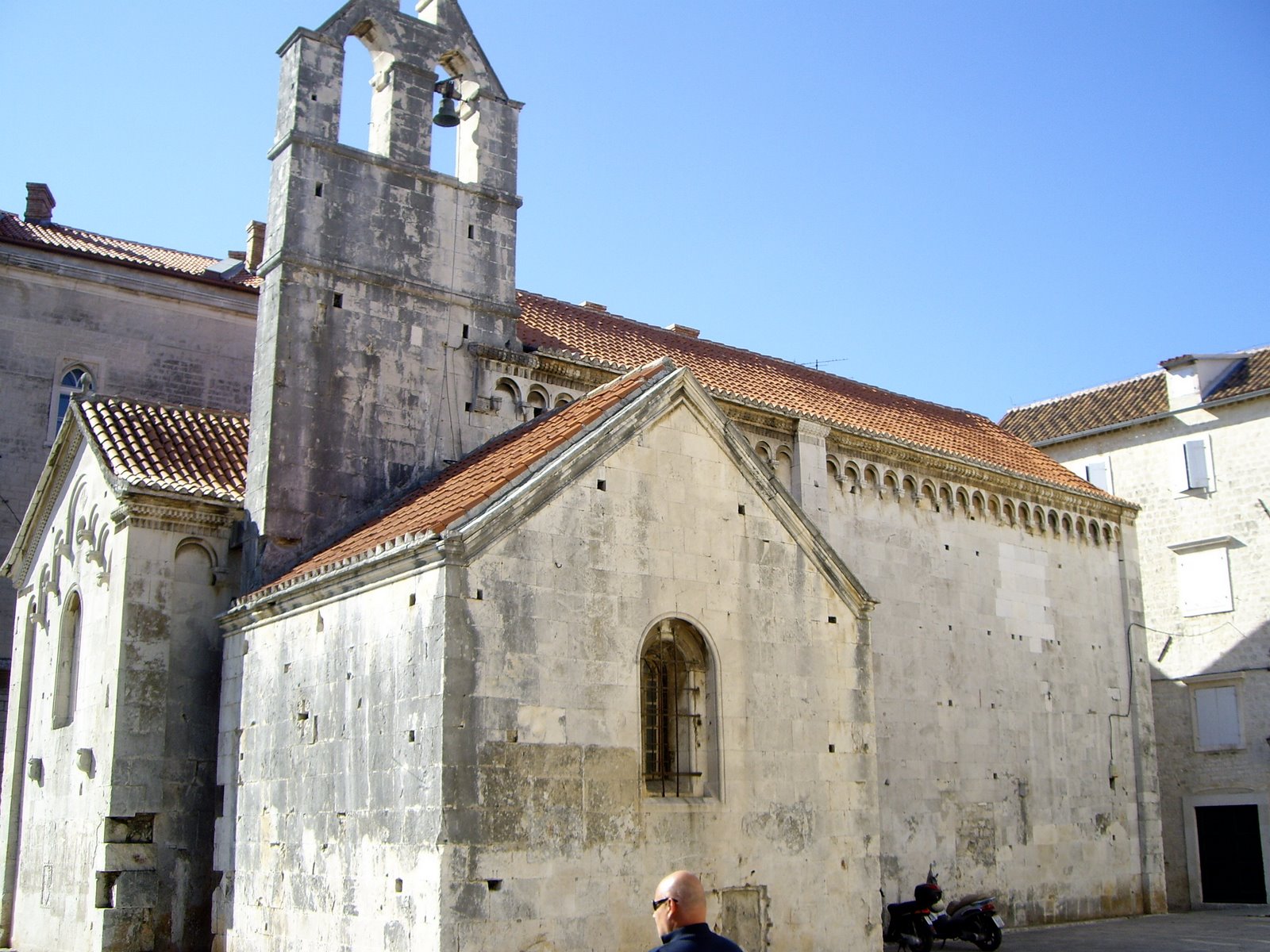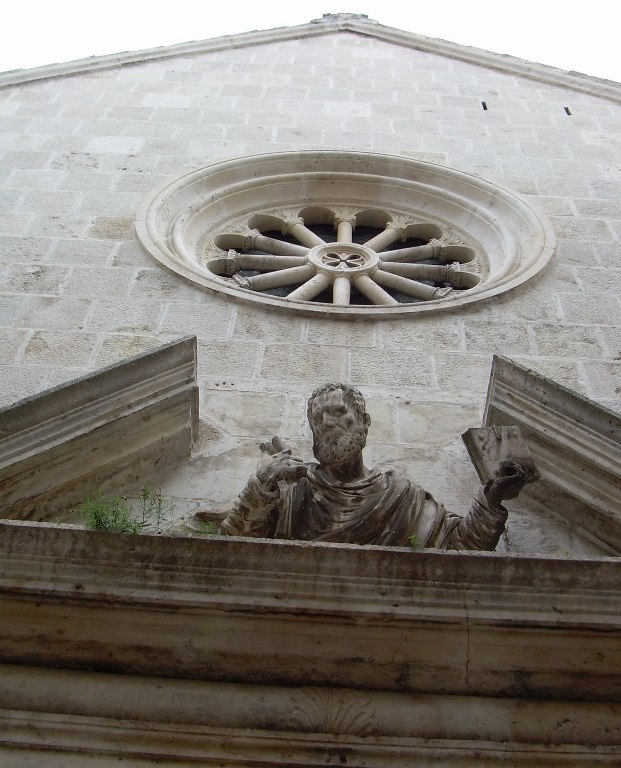You are here: ![]() > Trogir-en
> Must see
> Trogir-en
> Must see
TROGIR HIGHLIGHTS
Yes, It`s a city full of well-known iconic landmarks and must-sees, but it always helps to have some local knowledge. Here are some tips and insider information on the well-known (and lesser known) attractions of Trogir.
Chatedral -of-St-Lawrence
Chapel of the blessed Jonh of Trogir
Pinacotheque
Radovan's portal
The Benedictine Convent of St Nicholas
Convent of -St-Dominic`s
The main city square
St Sebastian with city clock tower
The city loggia
St Barbara's curch
The small Cipiko palace
The large Cipiko palace
St Peter's church
The Garagnin palace
Chatedral of St Lawrence
During structural repairs to the foundations of the bell tower in 1903, an altar consecrated to Hera was found, which might well warrant the assumption that there was once, on the site of today's cathedral, a shrine from at least the Greek and Roman period. The new foundations of St Lawrence' Cathedral were blessed at the beginning of the 13th century, after the old cathedral had been ruined in the Venetian destruction of the city in 1171.
The Romanesque cathedral was conceived as a three-nave basilica with a main nave considerably wider and higher then the side naves. In the lunette of the southern door is an inscription of 1213, mentioned Bishop Treguan „of Tuscan line“ and city rector Ilija, probably of the Kacic family.
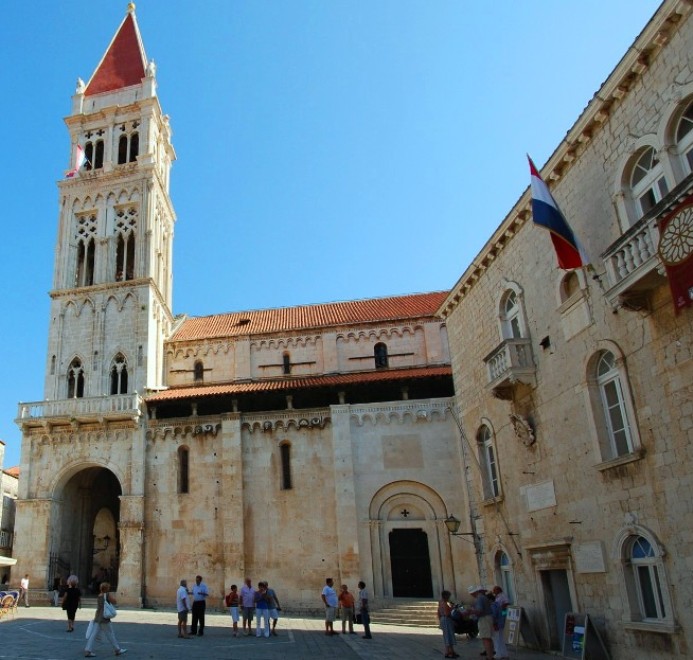
A bell tower started in the second half of the 13th century rises over the forcourt of the cathedral. Still, the bell tower that we see today was created in the renovation of the whole cathedral complex, severly damaged in the bombardment of the city in June 1420. The works on the first floor were run by Matija Gojković and Master Stjepan, father of the sculptor Ivan Duknovic. The second floor has all the stylistic features of Venetian Gotico fiorito, while the last floor of all with its pyramid was completed in 1603 by Tripun Bokanic.
Over the central part of central nave hangs a large crucifix by Blaž Jurjev of Trogir. It stands high over the entrance into the presbytery the choir stalls of which were carved in 1439 by Ivan Budislavic, which completed the several-decades-long campaign to remodel the interior of the cathedral after the bombarment by the Venetian fleet in 1420.
The northern arch of the early Gothic forecourt and the passage through it is closed by the baptistery, which was build by Andrija Alesi with help from Niccolo di Giovanni of Florence. The baptistery is a characteristic example of the synthesis of late Gothic and early Renaissance stylistic features, also drawing upon the characteristic coffered vaulting of the Split baptistery.
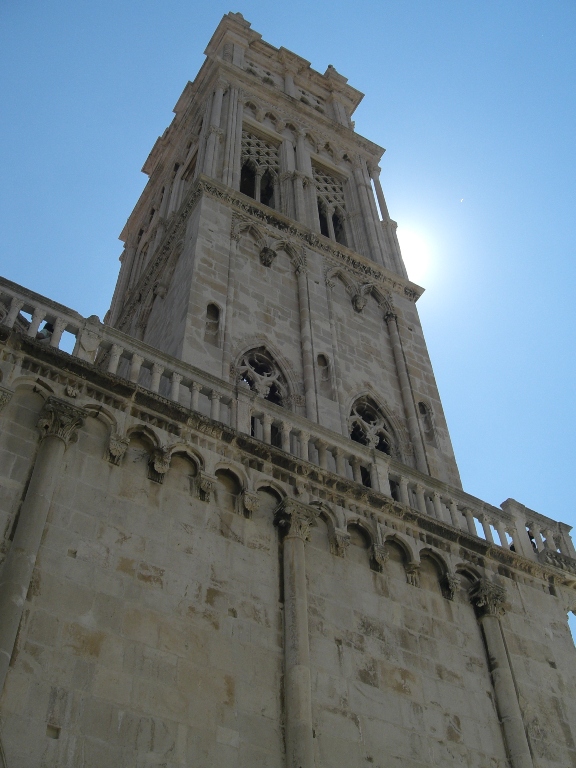
On the northern side, with a vow from Nikica Sobota, the Chapel of St Jerome was built in 1438-1446; master builders Nikola Racic and Marco Gruatto. In 1447 the thoroughgoing remodelling of the sacristy was begun. It was completed by Aleši in 1460. The carved and inlaid late Gothic armoire in the sacristy is the work of Trogir craftsman Grgur Vidov, brought from Venice by Koriolan Cipiko. Liturgical objects and relics are preserved in the Trasury: a seal of the Trogir chapter, gift of Elisabeth nee Kotromanic, widow of King Louis of the Angevins; there is a silver jug that according to tradition was also given by Queen Elisabeth; a mitre of Bishop Kazotic, studded with pearls; an ivory altar of the Embriachi workshop; a silver cross, the work of goldsmiths of Avignon – all works recently brilliantly restored and interpreted. Also interesting is the embroidered hood of a bishop's pluvial with a depiction of St Martin on a horseback sharing his cloak with the begger.
Immediatly after the baptistery was completed, a contract was signed to erect to new chapel to the Blessed John of Ursini in its amalgam of architecture and stone sculpture, this is a classic specimen of 15th century art.
Chapel of the blessed Jonh of Trogir
The batismal certificate of the chapel is preserved – an uncommonly detailed contract concerninig the beginning of its construction entered into January 4, 1468, in Trogir, between the master of the fabric of the cathedral, Niccolo Ciprianus, the stone mason Andrija Alesi and Koriolan Cipiko, who had a power of attorney from sculptor Niccolo di Giovanni of Florence and Ivan Duknovic, and four statues of Alessandro Vittoria were also carved for it (later moved to the attic of the bell tower after Baroque modifications, when four windows were opened up at the places of the original niches with statues). The initiator of the plan and the construction of the chapel was Koriolan Cipiko. The chapel, however, from the point of view of sculptures, is primarly the work of Niccolo di Giovanni, a pupil of Donatello.
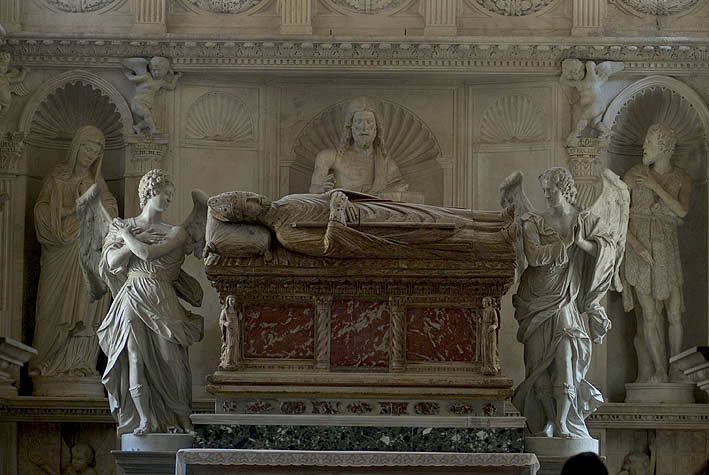
In the gallery of statues in the chapel, Duknovic's masterpiece of ca 1482 stands out – St John the Evangelist, a statue (second from the entrance on the left hand side) that under the toga of the saint hides the figure of Alvise, son of Koriolan Cipiko, raised to eminence by his poetic fame and honours of a prelate. To the left is a statue of St Thomas, also a work by Duknovic, but one of the last (1508). Among the works of Niccolo di Giovanni and his workshop, the finest are St John the Evangelist and St Paul in the zone of apostles, the Coronation of the Virgin in the lunette below the ceiling – with a gallery of angelic childlike faces, as well as a sequence of putti that symbolically bear the weight of the cornice, standing on the pilasters between the niches for the apostles, and in the ground floor a sequence of putti with torches, symbols of eternal life. The bust of the Creation in a medallion in the middle of vault is a Baroque facsimile of that of Niccolo (damaged and now in the Lapidarium of the municipal museum), the work of Ignacije Macanović of 1778. In its first two centuries the chapel was the mausoleum of Bishop Jacopo Turlon and the chapel of the holy sacrament, for the body of the Blessed John was moved to the chapel only in 1681. when a Gothic sarcophagus was brought into the Renaissaince chapel, and Baroque angles placed by it.
Pinacotheque
Pinacotheque of the cathedral is in the parish house. In the lobby to the Pinacotheque you can also see the archeologically presented remains of the hexafoil church of St Mary, mentioned as early as the beginning of the 8th century, but knocked down in 1851. Recently, one of its apses has been uncovered in the wall of the chapel of St Sebastian, with interesting Renaissance graffiti on the plaster. All through the Midlle Ages, under its window onto the square there was a sarcophagus upon which the people of Trogir were wont to make their vows.
Radovan's portal
A genuine trademark of Trogir sculpting is Master Radovan, the most important sculptor of Croatian medieval art. He signed his name on the main portal in an inscription that runs under the lunette and reliefs of the Annunciation at the side, where he is celebrated as “the best of all in this art“ (cunctis hac arte preclarum).
In the centre of the upper zone of the portal is a lunette in which Radovan managed to link into a united composition the scenes of Nativity, the Journey of the Magi and the Adoration of the Shepherds. At two ends at base of the arch that has wound around the lunette the master has shown the Annunciation, n the middle of the arch the Adoration of the Kings, to the right Joseph's Dream, and at the sides groups of angels celebrating. Radovan's lunette is the first European tympanum that takes the Nativity as the central theme of a whole facade. The starting point for a reading is the lunette – carved „a double face“ with a depiction of the Nativity on the front with a cross sign at the rear, one and the other provided with uncommonly exhaustive doctrinal declarations. The external frame of the portal is powerfully signalled with lion sculptures on brackets. To the right is a lion crushing a dragon, to the left a lioness holding a lamb in her paws, while two cubs sleep below her. At the base of the portal eight telamons are carved, bearing the pilasters of the portal on theirs backs. On the front side of the pilasters along the door is an incomplete cycle of the months (March and April on the left, December, January and February on the right), shown through activities associated with them and the appropriate zodiacal signs. And in the whole of the bottom zone is a system of scenes with the topic of sin and the state of the human race before the first laws were made.
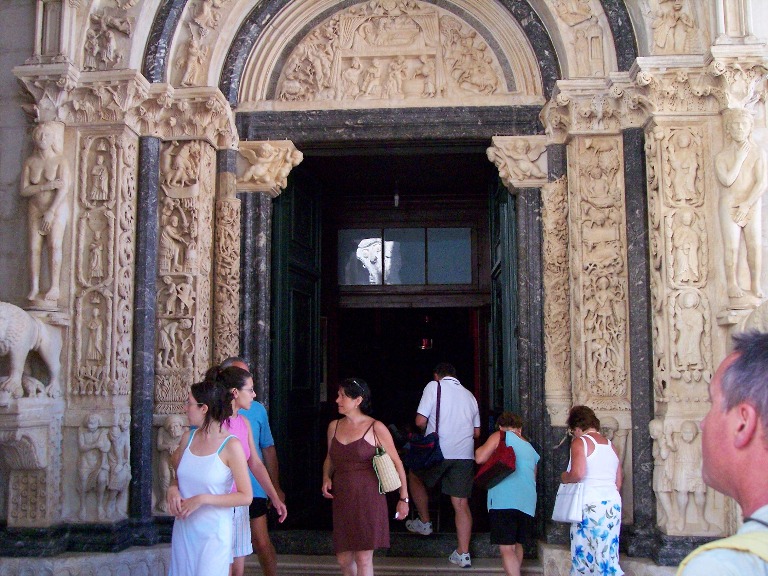
Today's portal unit was not created all at once. The original architectural and iconographic programme of the portal was considerably expanded in the last third of 13th century. Several craftsmen worked on the making of the new early Gothic frame; the contents of it underline the theme of a Sin and Redemption. The statues of the naked Adam and Eve, placed on the lions, represent Original Sin, and the scenes of the Incarnation and the Passion tell of the Redemption of Man. On the external pilasters (where Radovan had meant to show the other seasons) are six carved apostles, also an incomplete sequence, mediators of the Redemption. At the other external arch that develops around the lunette in the core of the upper scene are a number of other scenes in sequence: the Flight into Egypt (left end), Baptism in Jordan (opposite side), Temptation in the Desert (above the Baptism), and Entry into Jerusalem, Washing of the feet, Arrest, Flagellation, Crucifixion and Resurrection with the Three Marys.
The successors of Radovan should also be attributed the construction of the whole forecourt of the cathedral as well as the ciborium and the octagonal pulpit in the interior.
The Benedictine Convent of St. Nicholas
The church alongside the convent (founded in 1066) was put up on the side of the pre-Romanesque church of St Domnius. The interior was given a radical Baroque treatment in the mid -18th century (interesting Baroque stuccowork and altars). Over the pictures que altar, in 1598 Tripun Bokanic built a bell tower.
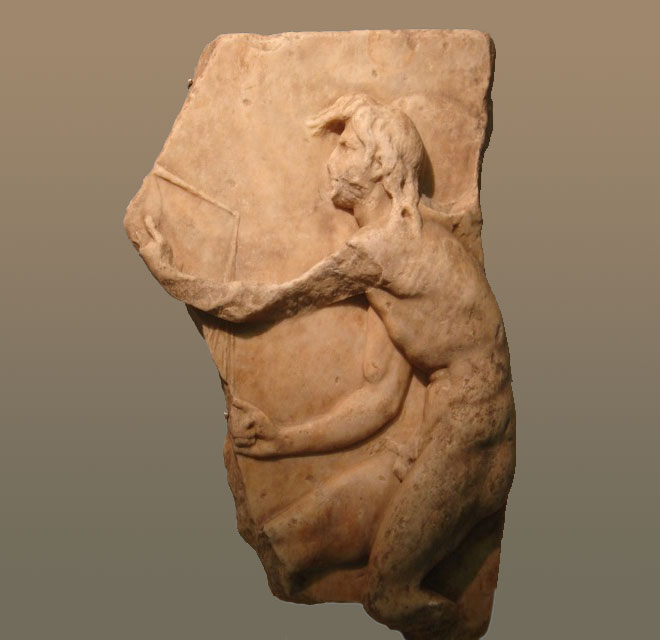
A 2nd century BC Greek inscription has been incorporated into the southern wall of the courtyard, mentioning the city magistrates. In the precious collection of artworks, the famed Kairos is on show, a relief with the figure of the youngest son of Zeus, the god of the lucky moment (4th or 3 rd century BC after on original of Lysippus). A relief with a description of Achilles listening of Prim`s plea to be given the body of Hector (3rd century) was uncovered in archeological excavations in the church. Among the pictures, an icon of Madonna and Child (second half of the 13th century, close to the style of the Master of the Burano Virgin, the oldest painting found in Trogir) and works of Paolo Veneziano, Blaz Jurjev, Antonio Zanchi, Nicollo Grassi stand out, in addition to a number of objects of liturgical vestments and vessels.
back to the top
Convent of St Dominic
The monastery was founded in 1265. The church with just a nave was built throughout the 14th century. In 1372 the rather mediocre Venetian sculptor Niccolo Dente did a lunette the Blessed Augustin Kazotic and St Mary Magdalene. His sister Bitkula, pious matron of Trogir and donatrix, kneels at the feet of the Blessed Augustin. In the interior is the tomb of Trogir Humanists Ivan and Simun Sobota, with whom the line of that important Trogir family became defunct, the work of Niccolo di Giovanni of 1469. Left of the triumphal arch is a lovely wooden altar with a picture of the Circumcision by Palma the Younger (1607). The convent cloister was seriously damaged in the Allied bombing of Trogir 1944. A number of valuable works of art are to be seen in the monastic collection (the buckle of a pluvial with a miniature and a polyptych of Blaz Jurjev of Trogir, as well as late Gothic reliquaries from the Dominican church of Holy Cross on Ciovo).
The main city square
The programme of designing the apperance of the main city square in Trogir, at the site of the Roman forum, started in the 1300 with the construction of the commune's loggia and the council chamber. The square aquired its final shape in a number of operations in the mid-15th century, at a time when the city really was renovated.
The interior court of the commune building had the features of the late Gothic style, with a staircase that, according to tradition, was made by Matej Gojković, master builder of the bell-tower in the 1420s. It was remolled by Niccolo di Giovanni the Florentine in the 1480s, and than by Tripun Bokanić. Many patician coats of arms are built into the walls of municipal council chamber.
St Sebastian with city clock tower
A the time of the deadful plague of 1465/66, which brought 2000 dead, it was decided that in future the feast of St Sebastian would be celebrated. In 1467 the vow of the city was fulfilled and, to a plan by Niccolo di Giovanni, a curch started to be built, located in the earlier atrium of the hexafoil churh of St Mary.
The construction was completed by 1482. The Renaissance altar with a statue of St Sebastian was partially reconstructed, which, like the statue of the saint on the facade, was work of Niccolo, while the statue of the Redeemer might be work of Aleši. The interior was recently arranged as a memorial space for the defenders of Trogir who fell recent Homeland War.
The city loggia
Originally was at the level of the square, and was linked with the hexafoil Early Croatian church of St Mary. Among the remodelled late Antiquity capitals that crown a number of recycled columns, only a corner, late Romanesque, basket capital can be distinguished.
The Altar of Justice is the masterpiece of Niccolo di Giovanni, which raised the paving of the loggia, turning into a rather grand judical tribune. Tripun Bokanić carved a new judical table and set up a new rail of the loggia with balusters. A relief with an equestrian likness of Croatian Ban and Bishop Petar Berislavić was carved by Ivan Meštrović in 1938.
St Barbara`s curch
A little three-nave basilica built in the 11th cetury via the remodelling of an earlier church, as told by inscription on an architrave of an altar screen, mentioning Petar an his wife Dobrica. It was long deconsecrated, up to its renovation in 1931 and in the 1980s.
The small Cipiko palace
Opposite the Baslica of St Martin or St Barbara. Over the steps in the countryard of the Small Cipiko palace in Trogir, on which Niccolo di Giovanni worked after 1470s, is a relief with a portrait of Alvise Cipiko, son of Koriolan, laurelled poet and later a high ranking prelate. The facade of the palace onto the square was restored by Ignacije Macanović.
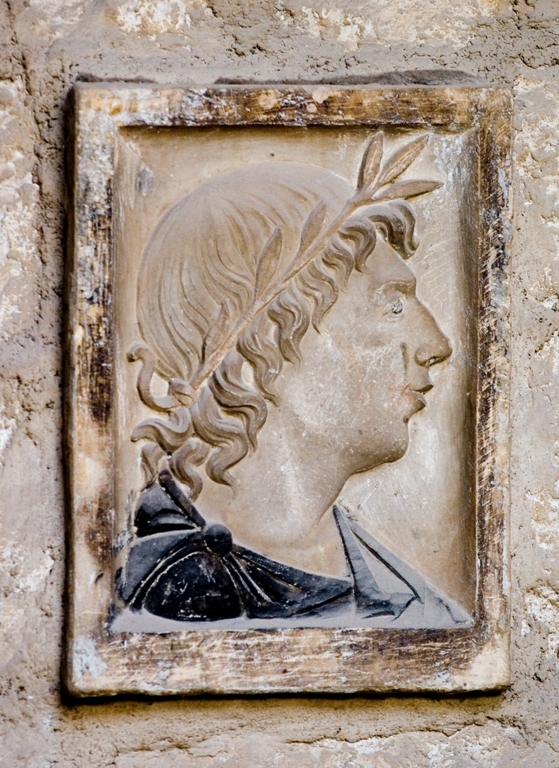
The large Cipiko palace
Father and son, Petar and Koriolan Cipiko, managed, clearly according to a certain family programme and with strategic marriages, to occupy the whole western side of the main square with their two palaces – opposite the council chamber, the cathedral and the other public buildings – furnishing them with an uncommon number of family coats of arms, clearly with princely pretensions.
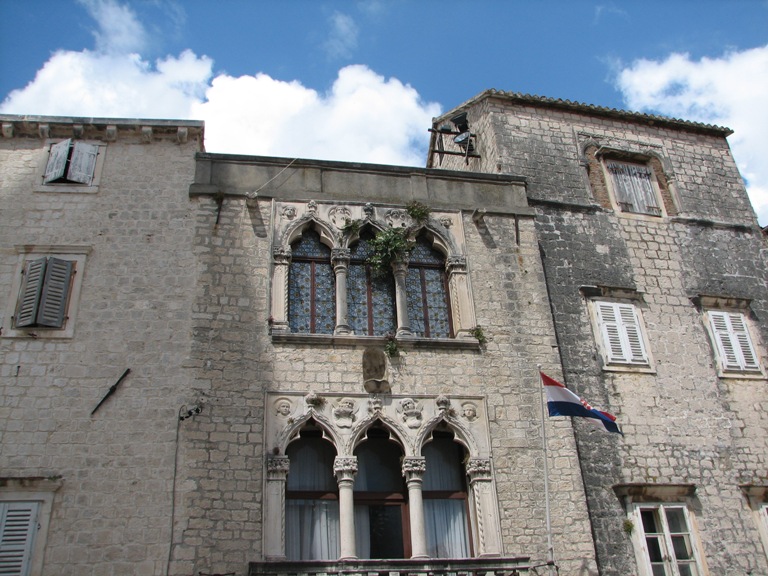
The southern portal, with medallions of angels bearing Koriolan's motto Nosce te Ipsum (Know thyself) is the work of Niccolo, around 1470. The northern portal, opposite the portal of the cathedral is the work of Ivan Duknović, fitted into the place, however, with Aleši three-mullion windows in the mid 17th century after the palace complex had been divided between two brothers and restored after the devastion by the Venetian militia that used the palaces as a barracks during the Cyprus War. The premises of the palace are today used by the Music School, some of the city departments, the Conservation department and part its privately owned.
St Peter's curch
This church belonged to another Benedictine convent, built alongside the medieval chapel of St Plato. Only the countryard with the Baroque well head is left of the cloister. The waist-lengt picture of St Petar built in over the Baroque portal of the church was carved by Niccolo di Giovanni, probably late in the 1480s. Among the pictures in the church, particulary interesting are those by Zanchi, Molinari and Lazzarini. At the end of the 17th century the sculptor Jakov Jucen was at work in Trogir, making a series of nice compositions in polychromed wood, and it was perhaps he that worked on the panelled ceiling and the housing of the organ. Over the high altar there are wooden statues of SS. Petar and Paul.
In the sequence of patrician palaces and houses, in addition to those already mentioned on the main square, the Lucic Palace is particulary prominent, within a complex of houses remodelled many times adjacent to the southern city walls. The northern facing facade with its lovely Renaissance portal and the courtyard with arcades and balconies are correlated with the remodelling of the palace undertaken by Jerolim Lucić, grandfather of celebrated historian Ivan Lucic, in the first half of the 16th century. Part of the ground floor and first floor of the assemblage were recently turned into the municipal library.
The Garagnin palace
Garagnin-Fanfogna palace from 1840 was converted in 1966 into Trogir Municipal Museum. It is composed of an assemblage of houses of different stylistic features (onto the main street there is a three mullion window with the coats of arms of Lipavic family, probably the work of Alesi) that were given a common denominator in a major Baroque overhoul, particulary in the monumental northern elevation and the lavish salons and stairs inside. The Garanin Fanfogna library with a number of very rare books (in the original ambience, with decorated ceilings and armories from 19th century) is the one of the few preserved old libraries in Dalmatia. In the museum set-up, as well as the valuable furniture, the paintings and statues, the archival documents and books a portrait of one of the owners of the palace, Ivan Luka Garagnin Jr (1764-1841) is exibited; he was an envoy to Napoleon in Paris in 1808, the first honorary conservator of monuments in Dalmatia.
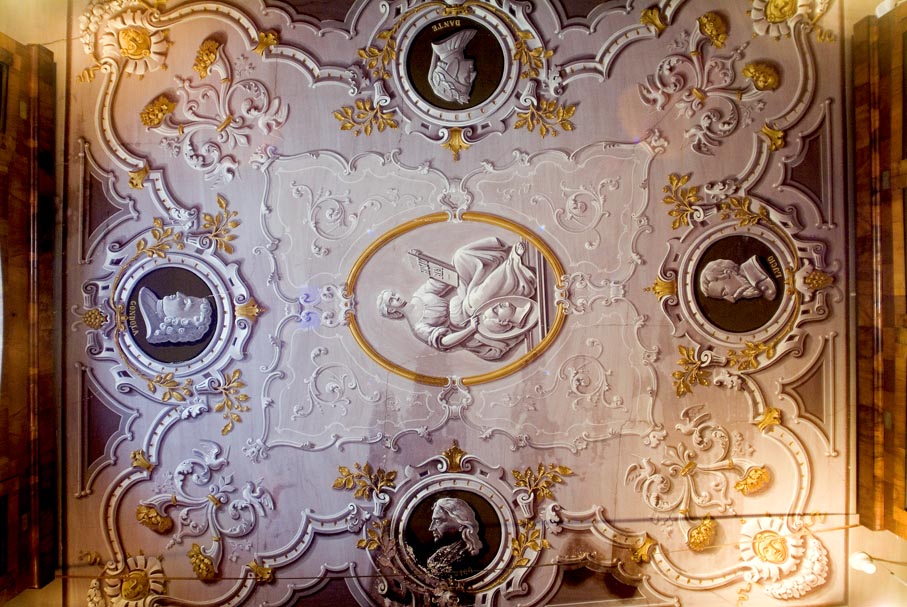
The paving of the courtyard (I. Macanovic) is particulary picturesque, with a little Romanesque two-storey house still surviving in the corner. The Lapidarium was opened in 1987 in the ground floor of the one-time utility wing in the court, after thoroughgoing archeological exavations had determined to a great extent our understanding of the earliest history of the town. The remains of a Hellenistic and medieval wall and a late Antiquity vaulted tomb are presented. Most important of the artefacts are sculptures of Duknovic, Alesi and Niccolo di Giovanni, with a number of other sculptures ranging from Antiquity to the Baroque.
At the end of the 18th century the Garagnin family laid out what were in that period very interesting grounds with a Lapidarium (on the whole fragments from Solin) on the mainland across the bridge, not far from the Dobrić spring, with buildings designed by Giannantonio Selva (who designed the Fenice theatre in Venice, as well ass the Garagnin villa nearby Divulje).

